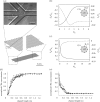Multi-scale heat and mass transfer modelling of cell and tissue cryopreservation
- PMID: 20047939
- PMCID: PMC3263795
- DOI: 10.1098/rsta.2009.0248
Multi-scale heat and mass transfer modelling of cell and tissue cryopreservation
Abstract
Cells and tissues undergo complex physical processes during cryopreservation. Understanding the underlying physical phenomena is critical to improve current cryopreservation methods and to develop new techniques. Here, we describe multi-scale approaches for modelling cell and tissue cryopreservation including heat transfer at macroscale level, crystallization, cell volume change and mass transport across cell membranes at microscale level. These multi-scale approaches allow us to study cell and tissue cryopreservation.
Figures





Similar articles
-
Thermal-mechanical deformation modelling of soft tissues for thermal ablation.Biomed Mater Eng. 2014;24(6):2299-310. doi: 10.3233/BME-141043. Biomed Mater Eng. 2014. PMID: 25226930
-
Lattice Boltzmann method for solving the bioheat equation.Phys Med Biol. 2008 Feb 7;53(3):N15-23. doi: 10.1088/0031-9155/53/3/N01. Epub 2008 Jan 14. Phys Med Biol. 2008. PMID: 18199898
-
Energy Dissipation in Ex Vivo Porcine Liver During Electrosurgery.IEEE Trans Biomed Eng. 2017 Jun;64(6):1211-1217. doi: 10.1109/TBME.2016.2595525. Epub 2016 Jul 27. IEEE Trans Biomed Eng. 2017. PMID: 27479955 Free PMC article.
-
Ratio of entropy to enthalpy in thermal transitions in biological tissues.J Biomed Opt. 2006 Jul-Aug;11(4):041108. doi: 10.1117/1.2343437. J Biomed Opt. 2006. PMID: 16965136 Review.
-
A review of heat transfer in human tooth--experimental characterization and mathematical modeling.Dent Mater. 2010 Jun;26(6):501-13. doi: 10.1016/j.dental.2010.02.009. Epub 2010 Mar 19. Dent Mater. 2010. PMID: 20303579 Review.
Cited by
-
Crystallisation Degree Analysis during Cryopreservation of Biological Tissue Applying Interval Arithmetic.Materials (Basel). 2023 Mar 9;16(6):2186. doi: 10.3390/ma16062186. Materials (Basel). 2023. PMID: 36984066 Free PMC article.
-
Engineering hydrogels as extracellular matrix mimics.Nanomedicine (Lond). 2010 Apr;5(3):469-84. doi: 10.2217/nnm.10.12. Nanomedicine (Lond). 2010. PMID: 20394538 Free PMC article. Review.
-
Testicular cryopreservation: From technical aspects to practical applications.Histol Histopathol. 2025 Jul;40(7):967-978. doi: 10.14670/HH-18-869. Epub 2025 Jan 2. Histol Histopathol. 2025. PMID: 39810720 Review.
-
Nanoliter droplet vitrification for oocyte cryopreservation.Nanomedicine (Lond). 2012 Apr;7(4):553-64. doi: 10.2217/nnm.11.145. Epub 2011 Dec 21. Nanomedicine (Lond). 2012. PMID: 22188180 Free PMC article.
-
Prediction and control of number of cells in microdroplets by stochastic modeling.Lab Chip. 2012 Nov 21;12(22):4884-93. doi: 10.1039/c2lc40523g. Lab Chip. 2012. PMID: 23034772 Free PMC article.
References
-
- Agca Y. 2000. Cryopreservation of oocyte and ovarian tissue. ILAR J 41, 207–220.. - PubMed
-
- Antaki P. J. 2005. New interpretation of non-Fourier heat conduction in processed meat. J. Heat. Transf. 127, 189–193.. (10.1115/1.1844540) - DOI
-
- Antinori M., Licata E., Dani G., Cerusico F., Versaci C., Antinori S. 2007. Cryotop vitrification of human oocytes results in high survival rate and healthy deliveries. Reprod. Biomed. Online 14, 72–79. - PubMed
-
- Arav A., Yavin S., Zeron Y., Natan D., Dekel I., Gacitua H. 2002. New trends in gamete’s cryopreservation. Mol. Cell. Endocrinol 187, 77–81.. - PubMed
Publication types
MeSH terms
Grants and funding
LinkOut - more resources
Full Text Sources

